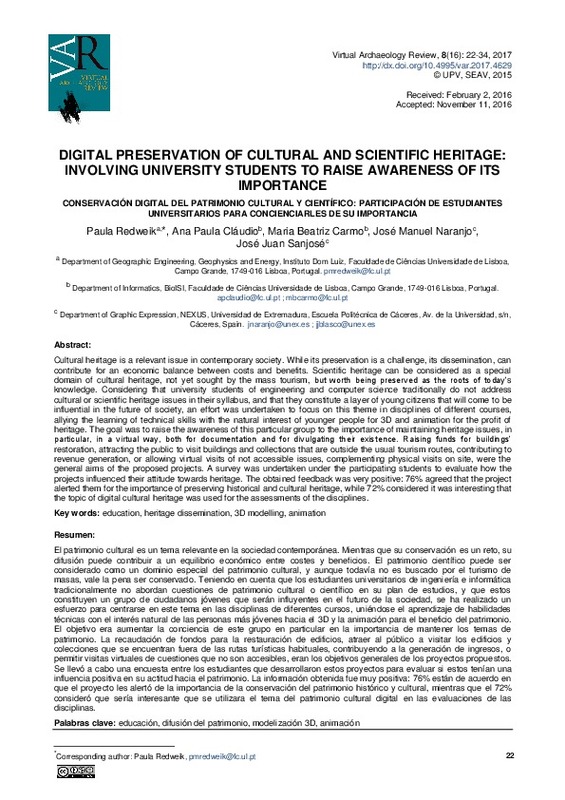|
Resumen:
|
[EN] Cultural heritage is a relevant issue in contemporary society. While its preservation is a challenge, its dissemination, can contribute for an economic balance between costs and benefits. Scientific heritage can ...[+]
[EN] Cultural heritage is a relevant issue in contemporary society. While its preservation is a challenge, its dissemination, can contribute for an economic balance between costs and benefits. Scientific heritage can be considered as a special domain of cultural heritage, not yet sought by the mass tourism, but worth being preserved as the roots of today’s knowledge. Considering that university students of engineering and computer science traditionally do not address cultural or scientific heritage issues in their syllabus, and that they constitute a layer of young citizens that will come to be influential in the future of society, an effort was undertaken to focus on this theme in disciplines of different courses, allying the learning of technical skills with the natural interest of younger people for 3D and animation for the profit of heritage. The goal was to raise the awareness of this particular group to the importance of maintaining heritage issues, in particular, in a virtual way, both for documentation and for divulgating their existence. Raising funds for buildings’ restoration, attracting the public to visit buildings and collections that are outside the usual tourism routes, contributing to revenue generation, or allowing virtual visits of not accessible issues, complementing physical visits on site, were the general aims of the proposed projects. A survey was undertaken under the participating students to evaluate how the projects influenced their attitude towards heritage. The obtained feedback was very positive: 76% agreed that the project alerted them for the importance of preserving historical and cultural heritage, while 72% considered it was interesting that the topic of digital cultural heritage was used for the assessments of the disciplines.
[-]
[ES] El patrimonio cultural es un tema relevante en la sociedad contemporánea. Mientras que su conservación es un reto, su difusión puede contribuir a un equilibrio económico entre costes y beneficios. El ...[+]
[ES] El patrimonio cultural es un tema relevante en la sociedad contemporánea. Mientras que su conservación es un reto, su difusión puede contribuir a un equilibrio económico entre costes y beneficios. El patrimonio científico puede ser considerado como un dominio especial del patrimonio cultural, y aunque todavía no es buscado por el turismo de masas, vale la pena ser conservado. Teniendo en cuenta que los estudiantes universitarios de ingeniería e informática tradicionalmente no abordan cuestiones de patrimonio cultural o científico en su plan de estudios, y que estos constituyen un grupo de ciudadanos jóvenes que serán influyentes en el futuro de la sociedad, se ha realizado un esfuerzo para centrarse en este tema en las disciplinas de diferentes cursos, uniéndose el aprendizaje de habilidades técnicas con el interés natural de las personas más jóvenes hacia el3D y la animación para el beneficio del patrimonio. El objetivo era aumentar la conciencia de este grupo en particular en la importancia de mantener los temas de patrimonio. La recaudación de fondos para la restauración de edificios, atraer al público a visitar los edificios y colecciones que se encuentran fuera de las rutas turísticas habituales, contribuyendo a la generación de ingresos, o permitir visitas virtuales de cuestiones que no son accesibles, eran los objetivos generales de los proyectos propuestos. Se llevóa cabo una encuesta entre los estudiantes que desarrollaron estos proyectos para evaluar si estos tenían una influencia positiva en su actitud hacia el patrimonio. La información obtenida fue muy positiva: 76% están de acuerdo en que el proyecto les alertó de la importancia de la conservación del patrimonio histórico y cultural,mientras que el 72% consideró que sería interesante que se utilizara el tema del patrimonio cultural digital enlas evaluaciones de las disciplinas.
[-]
|
|
Agradecimientos:
|
We acknowledge the students Pedro Lopes, Fernando Berenguer, Bogdan Rosu, Robin Burgess, Vitor Pinto, Marine Granger, Inês Gomes, Jorge Gomes, Rui Flores, João Moreira for their work in the models presented in this paper. ...[+]
We acknowledge the students Pedro Lopes, Fernando Berenguer, Bogdan Rosu, Robin Burgess, Vitor Pinto, Marine Granger, Inês Gomes, Jorge Gomes, Rui Flores, João Moreira for their work in the models presented in this paper. The projects were partially supported by the
R&D Unit BioISI, UID/MULTI/04046/2013 financed through FCT/MCTES/ PIDDAC, by the project PTDC/EMSENE/4525/2014 from FCT, Portugal, and by NEXUS, Spain.
[-]
|








